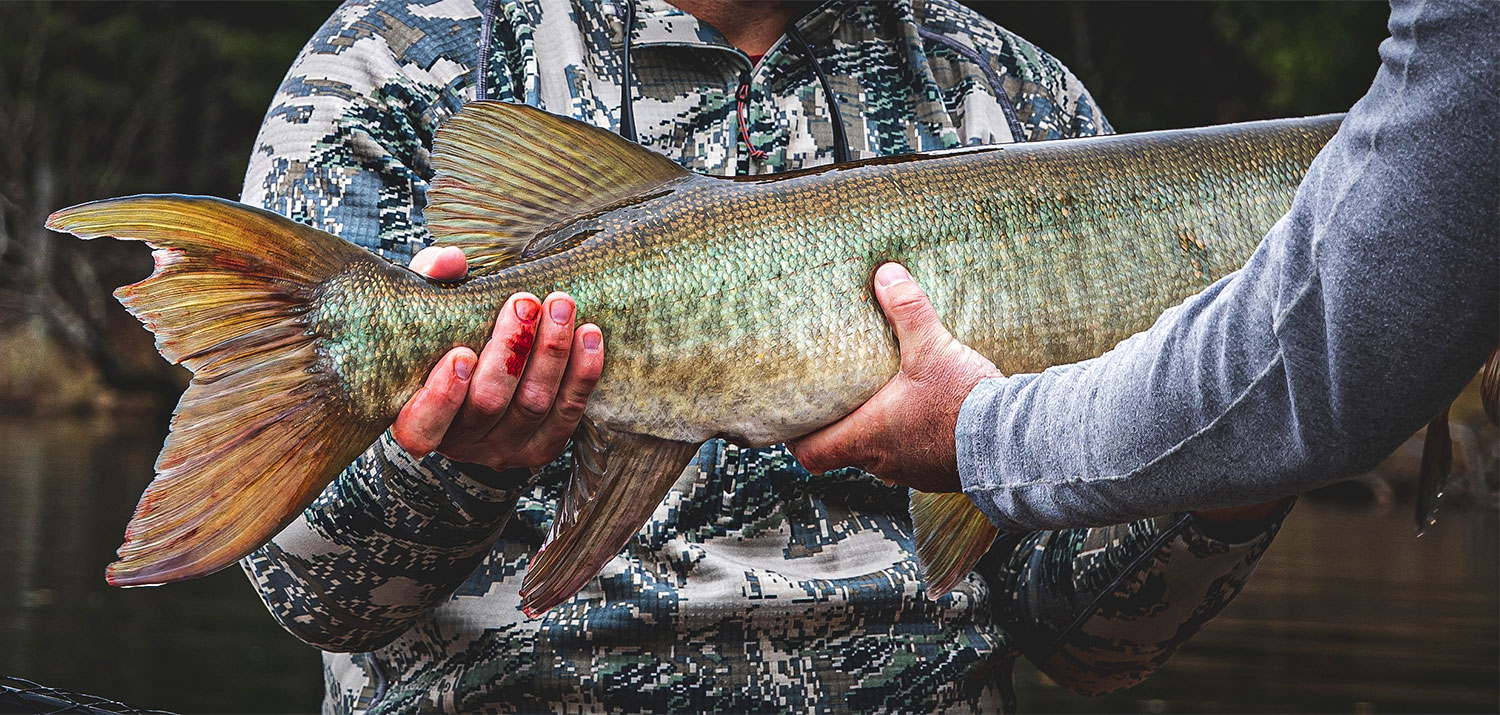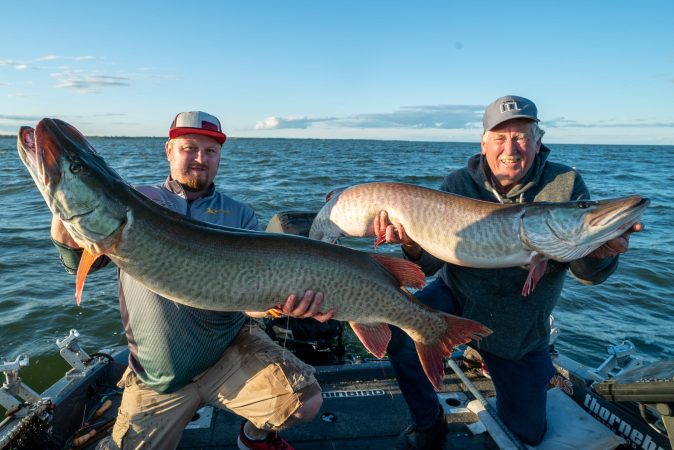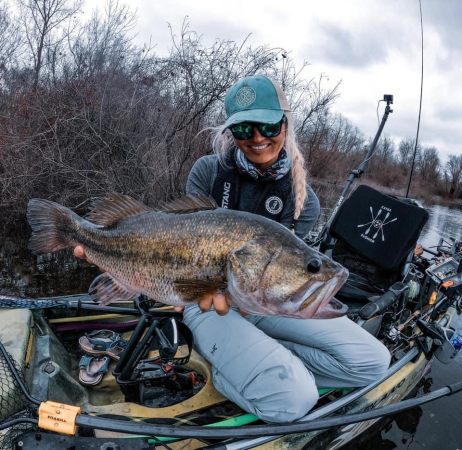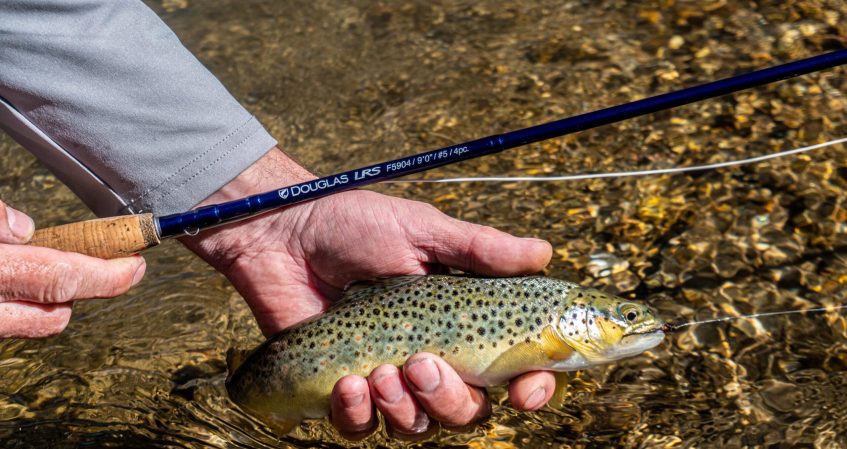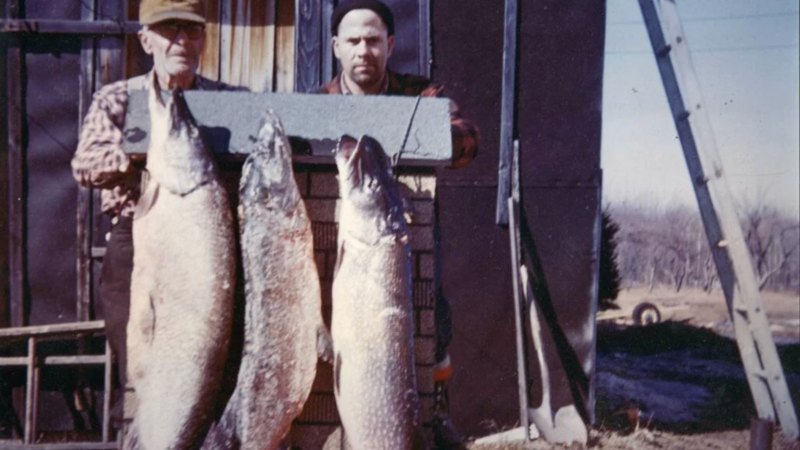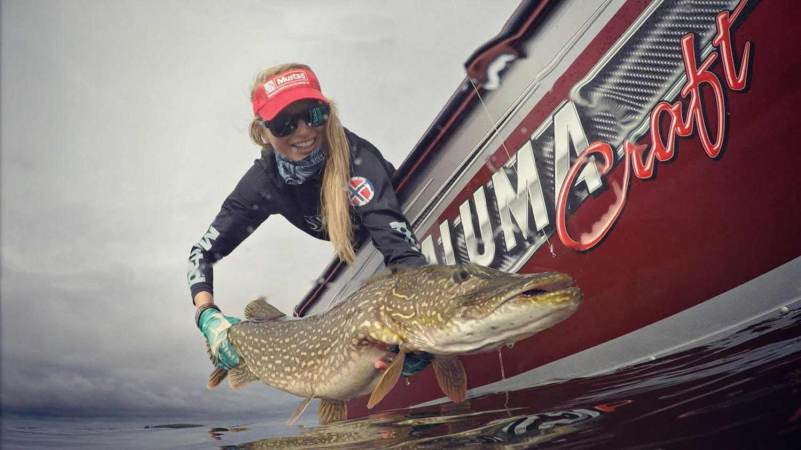The deeper Brandon Nelson, my buddy from GoPro, drives into Northern Wisconsin, the more I’m mesmerized. The land is a maze of hills, forests, farms, rivers, and lakes. Whitetails are everywhere, and I’m jealous how much water people in this part of the country have at their disposal. Someone could fish for smallmouth, walleye, pike, and catfish after a short drive in any direction—but for decades, muskie have remained the marquee headliner, and the town of Hayward, Wisconsin is celebrated as one of the prime muskie fishing spots in the world. There’s a museum-sized fish replica in the center of town in case you forget that fact.
Our main goal is to catch a muskie on a flyrod, and capture it all on video. However, I’m making the trek to this part of the country looking for something more than just a fish. If successful, I’ll finally achieve a goal I’ve spent years trying to realize, largely because of my family’s fabled relationship with muskie. Back in the early 1960s, my great grandfather caught one of the largest fish of his life by accident in Canada. He hoisted it in camp for photos, shared the meat with his family, and sprawled the fish’s dried head on a wood board. It was makeshift taxidermy at its best, and it resided in the basement of his Akron, Ohio home. As a kid, it terrified me. Decades later, I’ve spent countless hours chasing something just as large, often in his old boat, which I inherited. My dad has caught muskie, my uncle has caught muskie, but no matter how hard I’ve tried, I haven’t been able to land one … yet.
We’re hedging our mission on the so called “end-of-season-window.” It’s supposed to be the magical time in the heart of a musky’s late fall feeding frenzy when fish strap on the feed bag to prepare for winter and are supposedly “easier” to catch. Joining Brandon and I are friends JC Maldonado, and famed musky fly-fishing guides Jason Stewart and Brad Bohen, who achieved National Fresh Water Fishing Hall of Fame notoriety with a 51.25-inch, fly-caught musky.

Jason knows Hayward’s waters like the back of his hand. He recognizes what we need to do to be successful, I have to remain optimistic, and hopefully the fish work themselves into the scheme somehow. The five of us convene at a local bar, discuss the next day’s strategy, and get some last-minute coaching from Jason about being ready to set the hook after every cast. But I’ve played this game before, and it’s hard to always be ready to strike at something affectionately nicknamed the fish of 10,000 casts.
Frosted Fingers
Lying in bed and looking out the single-pane window above the headboard, I can already tell it’s colder than “normal” outside. Sparkling in the dim orange of first light is a ring of frost building on the glass, leaching most of the moisture from my bald, exposed head.
Despite the cold, we are all optimistic when we get to the water, organizing gear and preparing to launch. This narrow slot from the woods to the water is barely large enough for a drift boat, and it leads to a narrow tributary, which dumps into the mainstem 100 yards farther. It’s not an easy launch, but it’s on private property, so there’s no rush, and there’s something to be said for knowing you’re fishing water few are able to access.
The water is as clear as mud and we bump a few rocks on the way out of the forest canopy and into a massive swath of wild rice and Wisconsin water. I find my rhythm after my first few casts. Tossing big, air resistant flies isn’t quite like the graceful cadence of a rod and line dropping dry flies to rising trout. Musky lines are heavier than trout lines, and my casting loops are large and open, but when I get it right, there’s almost no structure too far to fish around.

This late in the fall, the noon sun arches over the horizon rather than pass directly overhead, and I am so cold I can barely feel anything. I squint to see through watery eyes, and my nose drips like a leaky faucet. Gloves keep my hands mostly dry, but I’m losing touch with my fingertips, and even the slightest breeze somehow finds its way to my base layers. My seemingly basic routine of cast, strip, figure-eight technique, and repeat, is becoming a laborious nightmare. Still, Jason encourages me to keep the faith.
“Something will eventually . . .” Before Jason finishes his sentence, I feel a fish strike. I don’t know if it’s a big bass, a pike, or the muskie I’m hunting for, but it happens in a flash, and I instantly know I did something wrong. A muskie hookset is not like a trout hookset. There’s no delicate, high-arching motion that softy impales a tiny hook. Instead, I need to make a level, straight, tug-of-war style pull on the line to bury the steel point in a fish’s mouth like Captain Ahab’s barbed harpoon in a whale.
It’s all over in an instant. The entire “opportunity” lasted less than a second, and when the line goes slack, I’m devastated. Jason doesn’t say a word, likely because I already know what he’s thinking. I fear my one and only chance for success just swam away.

A Muskie Stronghold
Before it became an angling destination, Hayward was known for its logging workforce and influence on America’s early industrial scene. Long before that, it was home to several Native American tribes that used the waterways for travel and food. The shallows of some area rivers are blanketed with swaths of wild rice, which is so abundant and easy to source, tribes fought wars for rights to the territory.
In July 1949, angler Cal Johnson inadvertently kick-started Wisconsin’s musky-hunting craze when he caught a 67-pound world-record behemoth in Lac Courte Oreilles. Despite the absence of social media, news of Johnson’s catch spread like wildfire, and Hayward seized the moment to lay claim as the Musky Capitol of the World.

“Essentially, Hayward got lucky when the glaciers receded, and all these fish were sorting out where they were going to establish themselves. A lot of native muskie landed in the area’s lakes and rivers, especially the Chippewa River system, and one of the things they didn’t have was competition from northern pike,” Wisconsin Department of Natural Resources fisheries biologist Max Wolter says. “For a long time, muskie remained the only game in town, and they’re well adapted for the resources here—particularly the dark-stained waters that the species does very well in.”
To Wolter’s point, any unsuspecting eye would take one look at the tea-hued lakes and rivers and condemn them as polluted, but nothing could be farther from the truth. This is some of the cleanest water around. The color comes from the rich natural and organic compounds absorbed from the surrounding bogs and landscape, and it’s actually a boon to muskies.
“The winning trait muskie have in these waters is that while visibility is tough, the fish is an ambush predator and has a full sensory arsenal to detect nearby prey. A lot of times, they’re reacting to things before they actually see what it is,” Wolter says. “Even more unique is the muskie strain around Hayward has its origins in flowing water, so the fish does as well in some rivers as in lakes.”
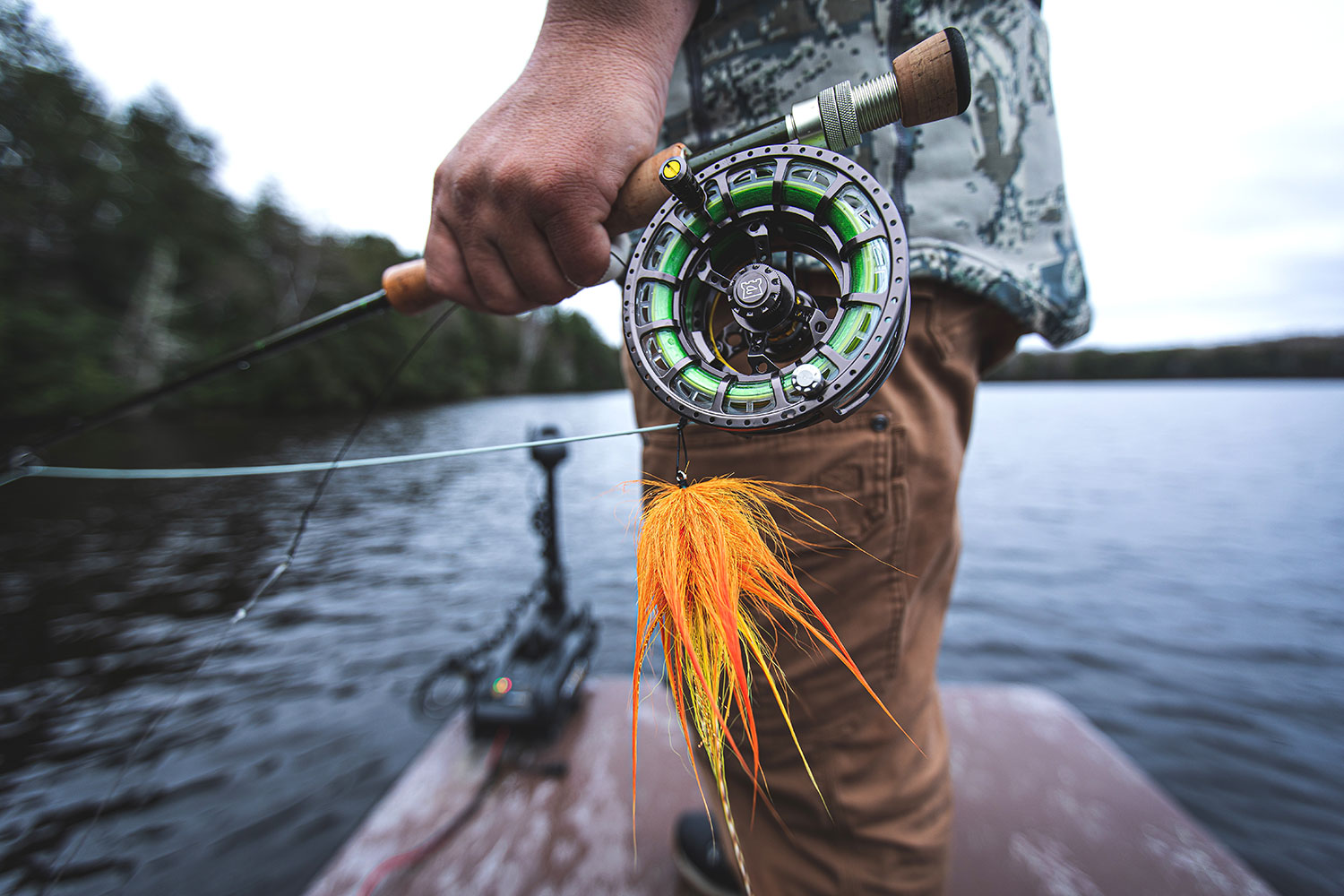
Wolters says a muskie living in the right conditions around Hayward can have a long life, even if it’s caught and released a few times. Biologists can clip off a portion of a fin and use it to date a specimen. Though lately, the best method has been to tag stocked fish, and compare notes and data whenever it’s caught and released or killed. So far, Wolter’s data shows migrations have less to do with water temperatures or food foraging, and more to do with mating.
“We know what’s possible because all these waters are interconnected, but it’s always interesting to see what actually happens,” Wolter says. “We have fish that routinely show up 10 or 12 miles away from where they’re initially tagged, which sometimes includes going through dams, especially during the spring spawning season when fish are looking for a territory to call their own, but that’s more common with downstream movements because once they pass, they can’t go back up.”
Thankfully, stocking programs and wild reproduction have kept muskie populations healthy for decades, even though the introduction of another voracious fish, the northern pike, which competes for the same food sources and spawning grounds, could’ve thrown the Esox masquinongy evolutionary chain off track in Hayward.

After the introduction of pike, another anomaly—the presence of tiger muskie—created a new buzz around Hayward. It’s not uncommon for a state fish agency to interbreed pike and muskie in a hatchery setting and release any fish strong enough to endure the program, but those fish are sterile—a safeguard to prevent the unnatural spread of a non-native species in habitats managed for native species.
“Pike and musky are forced to compete because they’re looking for the same habitat, the same prey, and they can hybridize, which is interesting,” Wolter says. “We see a lot of wild tiger muskies out here—and we don’t stock any, so we know the ones we find are naturally occurring.”
While Hayward’s muskie don’t have many problems when it comes to finding spawning habitat, Wolter says there is a growing concern over increased agricultural runoff from surrounding lawns and developments. The added nutrients from things like fertilizer create algae and organic growth in the water, and as plant material dies and settles on the lakebed, it becomes an oxygen-consuming sediment, which essentially suffocates fish. To help the state monitor the issue, Wolter said they’re getting help from radio tags and the good nature of the area’s outfitters and guides.
“We put passive integrated transponders (PIT) in fish handled in surveys, as well as stocked fish, which gives us a nice piece of data on a lot of different things. The tag is miniscule, and they use them across the country, especially in the West to study trout,” Wolter says.
Wolter says PITs aren’t the type of tag that helps someone in a boat run around with a radio antenna to find a fish. It’s the type of tag you scan with a ‘wand’ to identify the fish’s number assigned by the agency. Historically, it was up to biologists to find tagged fish and connect the data, which is tough. Years ago, guides and outfitters like Stewart and Bohen began helping because they handle dozens, if not hundreds, of muskies every year, and that’s an opportunity to get rare information biologists need.
Wolter says the program has also made more anglers aware of the department’s efforts, and how valuable one fish can be to an entire resource. Fish that would never make the trophy photo board at the tackle shop suddenly become interesting because you know its autobiography—and it is possible to learn more of its saga later.
“Since we started the PIT program, two fish really stand out. One was a muskie that’s been caught six times, both by our surveyors and anglers. It’s not a particularly big fish, but definitely a member of the frequent flyer program because he bounced around to so many lakes,” Wolter says. “Another notable was an angler who caught the exact same fish, on the exact same day, two years in a row. Quite an anomaly.”
Read Next: Pro Tips for Catching Muskie on the Fly
Optimism
The great thing about a new sunrise and fresh cup of coffee is it can make you forget about the day before. After greeting another orange sunrise through my frosted bedroom window, I join Brandon and JC seated at an old farm table in the kitchen and we discuss strategy over steaming cups of joe, no cream and no sugar.

Today, we’re exploring a lake split by a narrow channel. Both Jason and Brad know the water well. Its just a stone’s throw from Brad’s house and one of his favorite places to sneak in a little fishing on his days off. It’s easy to see why they like it so much. Tucked amongst rolling hills and thick forests full of cedar and hardwoods, there’s fog rising from the flat-calm water, and light from the rising sun makes it look especially mysterious. I can hear distant shotgun blasts from grouse hunters. If there is a quintessential Wisconsin lake, surely this is it.
Unlike yesterday, there’s not a breath of wind, but it’s still wicked cold. I dig out extra clothes and start layering and top it off with a black stocking hat I jokingly refer to as my “hairpiece” as Jason preps the boat. The name of the game is similar as the day before—work around the structure and keep the fly in the water—but with one additional element. Scattered throughout both lakes are shallow, submerged weed islands littered with baitfish. Every so often, I see dimples scatter across the surface like falling rain as minnows flee something large and toothy. Even more exciting, is seeing a wake or boil from a lunging muskie. Propelled by Jason’s trolling motor, we silently duck and weave around the weeds, casting in all directions.

The tannin-stained water makes it impossible to anticipate the moment of truth, so when a big fish swirls and turns, only to miss my fly, all I can think about is speeding up the retrieve to mimic a fleeing baitfish. But as the rings on the water slowly spread and dissipate, I worry I made a mistake.
As I bring the fly closer to the boat, I’m afforded a brief window into the water. There is definitely something there… it’s log shaped. It can’t be a fish. But that log is closing the distance. As I try to quickly sort through feelings of disbelief, time flips to slow motion.
In the water, I see a flat, shovel-shaped head rise into view. The fish opens its mouth and clamps down on my fly. Then, it just sits there, motionless, meeting my stare with its own, just a few feet from the boat. I’m in shock.
Amazingly, my body knows what to do even though my mind doesn’t. I point the rod tip at the fish, grab the line, and pull hard enough to start a lawnmower. The fish winces at the feeling of a 3/0 stinger sinking into its jaw, bursts like a torpedo straight at me, makes a last-second course correction, and sends water exploding into the air, just inches from my feet.

The ensuing fight is brutal, but short lived, and I’m able to coax the musky into Jason’s net without making the fish burn too much energy. Stretching to 45-inches long, it’s amazingly huge and healthy—a true representative of Hayward’s muskie gene pool.
I reach down to hoist it for a photo op, and while I’ve been warned to keep my digits far away from a muskie’s mouth, I’m riding a high, and common sense is out the window. Moving faster than I can react, the fish gets a piece of my left hand. When I reach with my right, history repeats itself. I’m sitting in a moment I can’t believe is happening, positioning the fish for the camera, and blood is streaming down both mitts. But I don’t care. Fingers heal.
If you want to know if you’re in a fishy place, visit the local watering hole. For better or worse, anglers, and hunters tend to apply human characteristics to our prey and talk about fish like its a neighbor or relative—referring to it as “he” or “she” instead of an “it.” If I had to typecast a musky, I’d say he’s the hulking lumberjack with a furled unibrow, hunched over the bar across the street from the boat ramp, nursing a beer, watching the world through the corner of his eye—ready to pounce on anyone who says something negative about the Packers. And when he decides to lurch, it’s not going to be pretty.

I don’t know when I’ll be able to get back to this part of the Midwest. Hopefully it’s sooner rather than later, and not just for the muskies. But also, for the beer, fried cheese curds, the German dinner clubs, a Packers game, and the good company.

Tips for Muskies on the Fly
If your bucket list includes catching a muskie on the fly, start by traveling to waters where musky populations are healthy. There are countless trophy muskie waters around the Hayward area, but there are other well-known destinations like Minnesota’s Lake Vermilion, and Lake of the Woods in Ontario and Manitoba to name a couple. Once you’re there, here are a few tips that will increase your odds of success.
• Speed it Up—If you’re lucky enough to see a muskie follow your fly, or even slash at it, don’t become mesmerized by the moment. Instead, speed up your stripping to imitate bait fleeing from certain danger. Much of the time a muskie will give chase and eat at the last moment.
• Be Sharp—Stewart is a stickler for sharp hooks, especially when fishing in moving water where a fly bouncing off rocks and boulders can quickly lose its laser-honed point. Keep a hook file with your gear and make a few passes down all sides of a point so it has no trouble piercing a musky’s hard mouth when the moment of truth arrives.
• Strip Set—One of the most common errors fly anglers (including yours truly) make while fishing for muskies is lifting the rod to set the hook because the motion is so engrained in our heads. To help avoid making this mistake, clip the point off a musky fly and practice casting and strip setting, especially if you can practice on water. This way you’ll gain some muscle memory and your reaction will be instinctual when a fish strikes.

